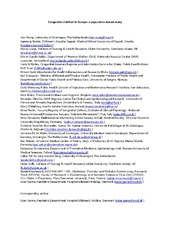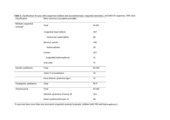| dc.contributor.author | Wang, Hao | en_US |
| dc.contributor.author | Barisic, Ingeborg | en_US |
| dc.contributor.author | Loane, Maria | en_US |
| dc.contributor.author | Addor, Marie-Claude | en_US |
| dc.contributor.author | Bailey, Linda M. | en_US |
| dc.contributor.author | Gatt, Miriam | en_US |
| dc.contributor.author | Klungsøyr, Kari | en_US |
| dc.contributor.author | Mokoroa, Olatz | en_US |
| dc.contributor.author | Nelen, Vera | en_US |
| dc.contributor.author | Neville, Amanda J. | en_US |
| dc.contributor.author | O'Mahony, Mary | en_US |
| dc.contributor.author | Pierini, Anna | en_US |
| dc.contributor.author | Rissmann, Anke | en_US |
| dc.contributor.author | Verellen-Dumoulin, Christine | en_US |
| dc.contributor.author | de Walle, Hermien E.K. | en_US |
| dc.contributor.author | Wiesel, Awi | en_US |
| dc.contributor.author | Wisniewska, Katarzyna | en_US |
| dc.contributor.author | de Jong van den Berg, Lolkje T.W. | en_US |
| dc.contributor.author | Dolk, Helen | en_US |
| dc.contributor.author | Khoshnood, Babak | en_US |
| dc.contributor.author | Garne, Ester | en_US |
| dc.date.accessioned | 2020-06-22T12:40:57Z | |
| dc.date.available | 2020-06-22T12:40:57Z | |
| dc.date.issued | 2019 | |
| dc.Published | Wang H, Barisic I, Loane M, Addor M, Bailey, Gatt M, Klungsøyr K, Mokoroa O, Nelen V, Neville AJ, O'Mahony M, Pierini A, Rissmann A, Verellen-Dumoulin C, de Walle HE, Wiesel A, Wisniewska K, de Jong van den Berg LT, Dolk H, Khoshnood B, Garne E. Congenital clubfoot in Europe: A population-based study. American Journal of Medical Genetics. Part A. 2019;179(4):595-601 | eng |
| dc.identifier.issn | 1552-4825 | |
| dc.identifier.issn | 1552-4833 | |
| dc.identifier.uri | https://hdl.handle.net/1956/22805 | |
| dc.description.abstract | We aimed to assess prevalence, birth outcome, associated anomalies and prenatal diagnosis of congenital clubfoot in Europe using data from the EUROCAT network, and to validate the recording of congenital clubfoot as a major congenital anomaly by EUROCAT registries. Cases of congenital clubfoot were included from 18 EUROCAT registries covering more than 4.8 million births in 1995–2011. Cases without chromosomal anomalies born during 2005–2009, were randomly selected for validation using a questionnaire on diagnostic details and treatment. There was 5,458 congenital clubfoot cases of which 5,056 (93%) were liveborn infants. Total prevalence of congenital clubfoot was 1.13 per 1,000 births (95% CI 1.10–1.16). Prevalence of congenital clubfoot without chromosomal anomaly was 1.08 per 1,000 births (95% CI 1.05–1.11) and prevalence of isolated congenital clubfoot was 0.92 per 1,000 births (95% CI 0.90–0.95), both with decreasing trends over time and large variations in prevalence by registry. The majority of cases were isolated congenital clubfoot (82%) and 11% had associated major congenital anomalies. Prenatal detection rate of isolated congenital clubfoot was 22% and increased over time. Among 301 validated congenital clubfoot cases, diagnosis was confirmed for 286 (95%). In conclusion, this large population‐based study found a decreasing trend of congenital clubfoot in Europe after 1999–2002, an increasing prenatal detection rate, and a high standard of coding of congenital clubfoot in EUROCAT. | en_US |
| dc.language.iso | eng | eng |
| dc.publisher | Wiley | eng |
| dc.title | Congenital clubfoot in Europe: A population-based study | en_US |
| dc.type | Peer reviewed | |
| dc.type | Journal article | |
| dc.date.updated | 2020-01-19T15:35:33Z | |
| dc.description.version | acceptedVersion | en_US |
| dc.rights.holder | Copyright 2019 Wiley Periodicals, Inc. | |
| dc.identifier.doi | https://doi.org/10.1002/ajmg.a.61067 | |
| dc.identifier.cristin | 1694687 | |
| dc.source.journal | American Journal of Medical Genetics. Part A | |

